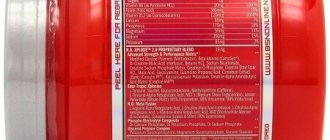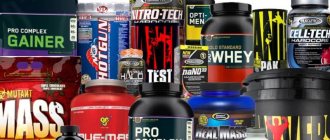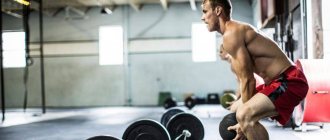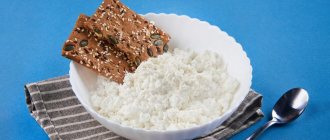Category: How to pump up Published 06/17/2017 · Comments: · Reading time: 5 min · Views: Post Views: 1,156
Fred Hatfield once shared the secrets of effectively using the “rest-pause” principle to grow muscle mass and strength. I will not list all his titles and knowledge, but most importantly, the scientific works that were written for bodybuilders, fitness instructors and powerlifting.
What does Fred pay special attention to? It is important not only to select the correct working weight, but also to literally maintain temporary rest pauses between approaches, since it is the observance of the time interval specified for each stage of training that allows you to achieve explosive growth in mass and strength.
However, get to the secrets of this bodybuilding principle sequentially, i.e. from simple to complex.
Method one: rest-pause for hypertrophy
- Start with a set of 6-10 reps using the highest possible weight.
- Rest for 15 seconds, taking deep breaths and exhaling, and continue performing a set with the same weight until failure.
- Repeat step 2 as many times as necessary (in most cases, 2 times is enough).
You will find that you can only do 2-3 repetitions in steps 2 and 3, but the effect will be much greater than regular repetitions.
Don't try to do multiple sets in a row using this technique. During one workout, it is recommended to perform no more than one approach using “rest-pause” for each muscle group.
This is a good technique for muscle hypertrophy, as the maximum level of muscle fatigue is achieved. This is also a great way to break through a plateau - the muscles are under enormous stress and react to it, so that the next time you do a regular set, you can do a few more reps.
Method #2 – Strengthening
1. 1-2 warm-up sets with a weight of 40% of the maximum weight - THIS IS MANDATORY!
2. Set the weight to 80-90% of your one-repetition maximum (this is the weight with which you can lift it cleanly without breaking technique just 1 time, if it’s a weight of 120 kg, then set the weight to around 100-110 kg);
3. Do 1 repetition with the calculated weight;
4. Rest for 40-45 seconds;
5. Perform as many repetitions as you can, no more than 8.
Reaching mega loads, muscle fibers are injured more, so rest increases , this is necessary so that blood flows to the places of ruptures and frees muscle areas from the process of protein breakdown, after which strength will increase slightly.
ENERGY SPEND RATE.
This is the most important parameter that is affected by the pace of the exercise. The less rest you take between reps, the more and “evenly” ATP (energy) is spent doing that work. The more you rest between reps, the less energy is spent doing the work, which means you can lift more weight.
Based on the principle of “specificity” in sports (what we train is what develops), we can draw a simple conclusion: if our goal is maximum strength, then pauses and slow speed of repetitions are much more important for us than the situation when our goal is maximum muscle mass.
Maximum muscle mass requires deeper and longer-lasting energy depletion than maximum muscle strength. Why?
There are a number of reasons for this. If we are talking about the RATE OF ENERGY SPENDING in muscles, then the main scientific idea of muscle hypertrophy is the NECESSITY FOR DEEP DEPLETION OF ENERGY RESERVES (ATP) WITHIN 15-30 SECONDS BEFORE ANAEROBIC GLYCOLYSIS TURN ON FULL. It is this rapid waste of energy that leads to failure and muscle damage. After which the processes of compensation and supercompensation (GROWTH) in the muscles are activated.
If you think about this well, then the need for lighter weights and shorter pauses between repetitions . It is these two factors that will allow you to do more work and deplete energy reserves in your muscles more smoothly.
Moreover, if you drop the weight on the bar (and for this you will need to take a long break, by the way) and continue working with less load, then this will deplete your energy reserves even DEEPER (than classic strength work) because you will have to expend more energy.
In other words, Slow Tempo (rest 5-20 seconds between repetitions) can be used both for the purpose of developing strength and for the purpose of developing muscle mass. Everything will depend on the number of repetitions.
FORCE
Few repetitions (1-3) + long pause (from 20 sec) + repeat again This is a classic way to develop maximum strength. High-threshold Fast Muscle Fibers are trained because... the load is submaximal or maximum. Trains the simultaneous activation of motor units in the muscle (brain-muscle connection). Joints and ligaments are loaded (Golgi tendon complex, etc.) This is how many strength athletes train.
M. MASSA
Many repetitions (6-15) + short pause to release weight (5-10 sec) + repeat again. This is already hypertrophy. Fast Muscle Fibers are involved (if the speed is fast and the amplitude is full) + “energy tanks” (sarcaplasmic hypertrophy, glycogen, circulatory system, etc.). The muscles' ability to store and expend a lot of energy is trained during strength work, usually lasting up to 30 seconds.
This is very close to the main difference between bodybuilders and powerlifters. The first train the muscles to perform a “large volume” of power work with minimal rest . And the latter train the muscles to perform rare but maximum tensions.
BLOOD FLOW
The second most important parameter is influenced by the speed and duration of rest between repetitions. The main reason is related to blood vessels. When the muscle is relaxed at its lowest point, blood can easily flow in and out of the muscles through the vessels.
When a muscle contracts, the blood vessels are pinched and blood flow becomes difficult. In practice this is expressed as follows:
- The shorter the pause between repetitions, the better the pumping, the more difficult it is for blood to get into and out of the muscle.
- The longer the pause between repetitions, the worse the pumping, the easier blood flows into and out of the muscle.
What does all this mean for muscle training? Direct. This actively affects the training of Slow Muscle Fibers because without blood supply, oxygen does not enter the muscles, which means that SMVs are forced to use anaerobic (oxygen-free) glycolysis, which is not typical for them (slow fibers are very hardy, usually due to the fact that they use oxygen methods energy supply). It is in this case that you can quickly deplete energy reserves and achieve failure (burning in the muscles) and subsequent muscle growth.
In addition, PAMPING actively promotes the development of the capillary network in the muscles themselves, which is very important both for the transport of nutrients to the muscles and for the visual hypertrophy of the muscles themselves.
BURNING IN THE MUSCLES
Another important parameter. When the weight on the bar is lighter, you can do more repetitions and drive more blood into the muscles. At the end of this approach, you feel a burning sensation. Moreover, the smaller the pause between repetitions and the more repetitions, the stronger the burning sensation you feel. What does this mean?
A burning sensation indicates that ACID is active in your muscles!!! Lactic acid as a by-product of ATP resynthesis using GLYCOLYSIS 1 glucose + enzymes + ADP = 2 lactic acid + 2 ATP + water
Why is it important? Because lactic acid is broken down into LACTATE and HYDROGEN ION. ATP = ADP + P + H (+ hydrogen ion) + E (energy)
It is HYDROGEN IONS that unwind those DNA helices that store information about protein synthesis. And hormones trigger the process of duplicating this information, which leads to the growth of your muscles.
By doing a large number of repetitions with minimal or no rest, the bodybuilder acidifies the muscles as much as possible, increasing the concentration of hydrogen ions, which are so necessary for the rapid synthesis of proteins in the muscles. Moreover, this is important for both MMV and BMW.
PROFESSIONALS
Many of you have seen the training of professional bodybuilders. Perhaps you were sometimes surprised by their manner of doing repetitions quickly (without pausing at the bottom). The reason, as you now understand, is very simple - in this way, a deeper depletion of energy is achieved, which means there is better stimulation of subsequent growth both due to myofiril hypertrophy and due to sarcoplasmic hypertrophy .
In addition, this method of performing repetitions is safer (for ligaments, joints and muscles) because the load is “flat” and does not jump from complete “zero” to “100%”.
What's the disadvantage? Strength...High-threshold Fast Muscle Fibers "sleep" because... the load is far from submaximal. (therefore, the difference in weight between a working approach and a one-time maximum in an exercise is minimal for a bodybuilder, and maximum for a lifter). In addition, any “squeezing” of the vessels (pumping) makes it difficult to pump blood through them, which means the heart has to contract harder to pump blood around a large circle.
CONCLUSIONS
To develop maximum muscle strength, PAUSES between repetitions must be LONGER than to develop maximum muscle mass.
Muscle mass is made up of a number of components: myofibrillar hypertrophy (MMH + MMH), sarcoplasmic hypertrophy, capillary network, etc.
All these components are related to the volume of strength work (the greater the volume, the greater the hypertrophy). Therefore, shortening pauses between repetitions, as a way to increase the volume of work in training, is in most cases better suited for hypertrophy than lengthening pauses.
On the other hand , lengthening the pauses will allow you to lift more weight, which can later be used to increase the volume of work . I think that both methods have a right to life in the training of a pure bodybuilder. You just need to take into account the athlete’s experience. The more muscles a person has, the more difficult it is for him to provide them with all the necessary set of nutrients and the greater the likelihood of injury due to the strength of the muscle fiber. In such situations, it will be especially useful to shorten the pause between repetitions in order to reduce the weight and distribute the load more evenly for safety.
In other words, the more muscle a bodybuilder has, the less it makes sense for him to pause between repetitions in an exercise.
PRACTICE
In practice, this will result in the following. When a person just comes to the gym, he can pause quite long. 1-2 seconds. It can even alternate i.e. do repetitions in turns (lifting the left bicep...lifting the right, etc.).
However, as muscle size increases, the main training should change towards shortening the pause between repetitions. If an experienced bodybuilder is doing dumbbell curls, then it makes sense for him to do a full series on his left arm, and then do a full series on his right. Moreover, after this, he can repeat this circle again without a pause. In this version, the “rest-pause” principle for size hypertrophy will work better than in classic strength training.
Remember that shortening the rest between reps makes the exercise more taxing on your muscles and energy. This means it is better suited for hypertrophy.
Basic requirements of high-intensity training
Let's consider the requirements for high-intensity training:
- It is necessary to approach the exercises thoughtfully and under control. Throwing or hitting heavy weights can cause joint injury. Therefore this cannot be done. Injuries are possible due to jerks and rebounds, as well as the use of inertia. The lifting of impressive loads itself does not injure you.
- Focus on negative repetitions. According to experts, it is this phase that helps achieve the greatest effect during superstrength training.
- The number of sets must be limited - a maximum of three sets per body part. When you notice progress, you will of course want to do more sets, because your enthusiasm and energy will increase. But self-restraint is very important here: you need to do everything possible to restore the body, which cannot happen with a large number of high-intensity sets.
- You cannot train more than once in four to seven days. If after using the rest-pause technique there are no results, it means that you are not allowing the body to recover - you are not providing the necessary time for this. Given sufficient intensity, lack of recovery is the only factor holding back progress.
Recommendations
» It doesn’t matter if you use the first or second method always do stretching , pre-warm up your joints and ligaments on an exercise bike, orbitrek, lightly running or jumping rope;
» Do not use the “rest-pause” method every workout, use it no more than 2 times a month for each muscle group, otherwise overtraining will occur, followed by a stop in the growth of strength and mass;
» ALWAYS do it with a partner, don’t pretend to be a cowboy, the weight can crush you so much that you end up on the bench











